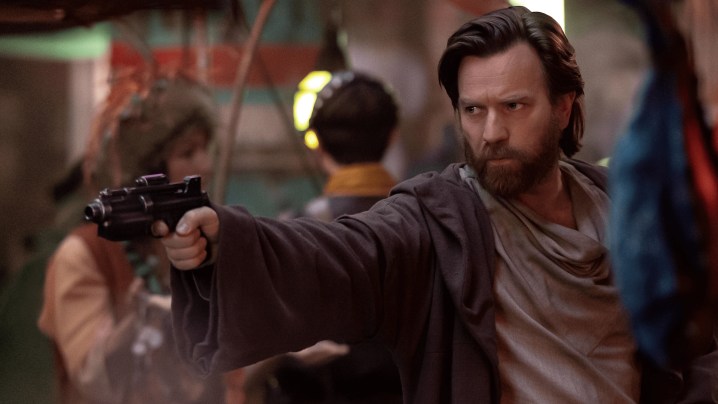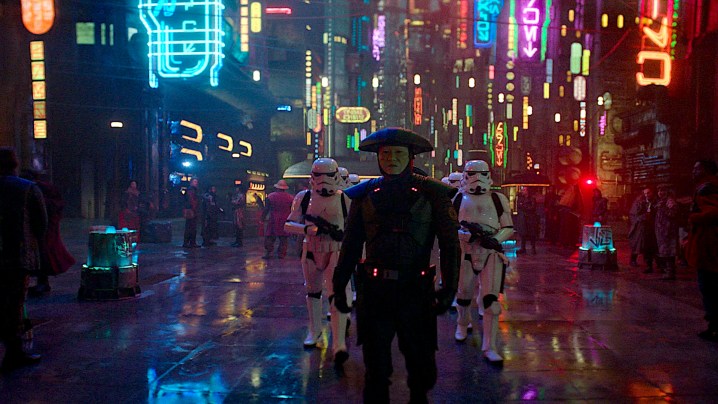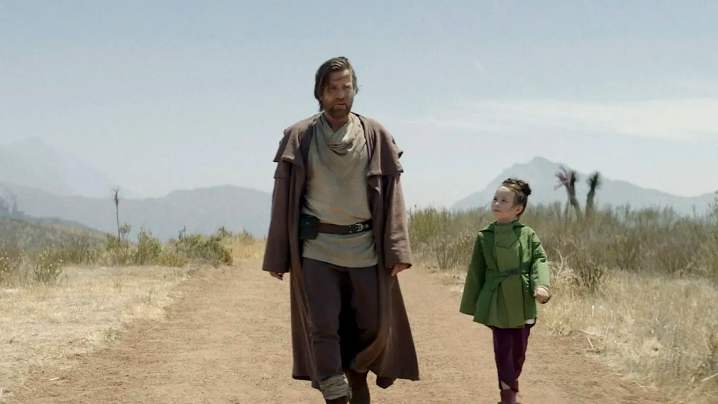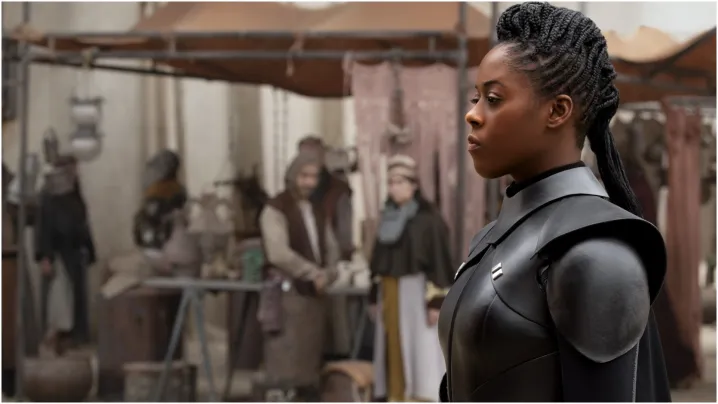Obi-Wan Kenobi launched this spring in a flurry of excitement that included breathless articles suddenly proclaiming the merits of the prequels. Fans not only hoped to see Obi-Wan and Anakin Skywalker/Darth Vader again — the protagonists turned adversaries of Star Wars Episodes I-III — but they were also psyched to see them played by the original actors, Ewan McGregor and Hayden Christensen. As such, many were thrilled when the show debuted. Then, slowly, the realization that comes with almost every Star Wars project dawned … this isn’t that great, is it?
This is why every Star Wars show and movie has been recut, rewritten, restaged, reconceptualized, and regurgitated by online fans — to make better quality Star Wars. The most recent fan remix to attain wider attention — even getting a write-up in Variety — is Kai Patterson’s compression of the show’s six episodes into a feature-length film of two and a half hours, which Patterson created to fix things “that were easily fixable in the script and in the edit.”
Does this new version indeed “fix” the show’s issues? Is it better? Is it yet another example of how the application of a little more common-sense storytelling and filmmaking could radically improve a flawed original? Obi-Wan Kenobi the series certainly had its problems, but if Disney had opted to go the movie route like Patterson’s edit did, does that make it a better Star Wars experience?
Issues with the series

The show begins slowly. Do we really need to see Obi-Wan at his blue-collar job three separate times to get a sense of his life in hiding 10 years after the events of the prequels? But viewers had patience with the setup because of the massively reassuring presence of Ewan McGregor (who is even better as the character in the series), as well as the introduction of that precocious future Hutt strangler, 10-year-old Leia Organa (Vivien Lyra Blair). There are other good bits in the first episode, including an exciting opening sequence in which Younglings escape the Emperor’s Jedi purge from Revenge of the Sith.
The second episode, in which Obi-Wan searches for the kidnapped Leia, feels a tad rushed, but the action and VFX are engaging, and the Inquisitor Reva (Moses Ingram) makes for a sufficiently diabolical villain. More importantly, after spending way too much time on that insufferable sandball, Tatooine, in The Book of Boba Fett and The Mandalorian, Star Wars finally departs for a different hive of scum and villainy: the cool Blade-Runner-ish planet, Daiyu.
The third episode gave viewers a real belief that Disney had got this series right. The episode features a chilling appearance by Darth Vader that rivals even his classic Rogue One appearance. The savagery of Vader’s fight with Obi-Wan, the intensity of his hate, and Obi-Wan’s complete lack of preparation for the encounter are moving and disturbing.

The show then delivered its first weak episode. Not only is episode 4 a lil’ Leia rescue mission just two episodes after the first one, but it is yet another “homage” to a previous Star Wars story, the rescue of Leia from the Death Star in A New Hope, already “reimagined” as the rescue of Rey (Daisy Ridley) from Starkiller Base in The Force Awakens.
It was this episode that had some viewers wondering if the show was in trouble. Among other issues, Obi-Wan is all but fine after suffering serious physical and psychological wounds at the hands of Vader at the end of the third episode. Then he and the Jedi sympathizer Tala (Indira Varma) easily infiltrate a supposedly impregnable Imperial base, with Obi-Wan using a breathing apparatus to sneak in underwater.
Unfortunately, the episode misses a beat when Obi-Wan is later trying to hold off a phalanx of stormtroopers and the ocean threatens to flood the corridor he’s in. He uses the Force to keep the plexiglass wall from imploding while being fired upon and all I could think was, “YOU HAVE A BREATHING APPARATUS WITH YOU. Put it in, drown these mothers, and swim out of there!”
Alas, no such elegant payoff emerges from the earlier setup, which more or less sums up the series as a whole. Then we get the now infamous scene in which Obi-Wan and Tala stride out of the stronghold with Leia stashed underneath a trench coat. Even assuming that a trench coat would be on hand (for cosplay maybe?) it appears that Imperial officers have a pretty rigid facial hair code and Obi-Wan looks like Rip Van Winkle after a rough hypersleep.
Episode 5 is an improvement, and maybe the best episode of the series. Not only does it provide more Vader badassery, but as more of Reva’s backstory and motivation are revealed, we recognize her as a more sympathetic and compelling figure. Finally, we get to see Hayden Christensen as young Anakin in an elegantly staged training duel flashback with Obi-Wan.

The final episode undoes much of what the penultimate episode restores, not only because of the cringe dialogue and lazy plotting but in the way it shows how the settled Star Wars canon constrains the drama. The episode delivers parallel subplots in which Vader and Obi-Wan clash on Tatooine, while Reva threatened young Luke Skywalker at his homestead. But because we know that neither Luke nor Obi-Wan is in real danger, both plots feel rushed and anticlimactic, even if the battle between Vader and Obi-Wan does provide some emotional closure for their relationship.
Even the details are wrong, something for which Star Wars can typically be relied upon. After what we know that Star Destroyers can do with tractor beams and squads of TIEs, how they completely annihilated all those First Order cruisers in The Last Jedi, for example, suddenly Vader’s Star Destroyer can’t hit or catch a piece of junk that’s barely ahead of it (never mind the many heartfelt conversations our heroes make time for on the ship when they’re supposedly seconds from death). Finally, the filmmaking is subpar in this episode. Even on the Dolby Dark settings on my new TV, I could barely see the action during any night scene not lit by lightsaber (didn’t Game of Thrones teach them anything?). It feels like an attempt by the filmmakers to stretch the technology, but it ends up being impenetrable.
Nowhere to go

The overall issue with Obi-Wan Kenobi was that it never had anywhere to go. Everything is more or less in the same place as it was when we started except that Qui-Gon Jinn (Liam Neeson) finally shows up after a decade of making Taken movies or who knows what to keep Obi-Wan company in the desert until the events of A New Hope. And yet, we always knew the show would dead-end narratively because there is no genuine peril for any of the legacy characters. Could it have been more suspenseful and emotionally involving? The showrunners tried with Reva’s arc, given that it didn’t have a foregone conclusion, but bungled it with the ham-fisted treatment of her character in the final episode.
So what are we left with? Some cool new environments, some great lightsaber battles (which virtually every iteration of Star Wars has), some nice moments with Obi-Wan, Leia, and the Organas, some immortal Vader wickedness — in all a few above-average episodes along with a few mediocre ones.
What does the movie version change?

Patterson’s stated goal for his version was to improve pacing and get rid of the fluff. He generally achieves this by cutting the most material from the three weakest episodes: 1, 4, and 6. He entirely excises the subplot in which Reva goes to the Skywalker homestead, by far the weakest part of the series. This makes the final battle between Obi-Wan and Anakin more impactful. Although Star Wars is famous for its effective use of parallel action, Patterson shows that the better choice here is to let the duel build without interruption to its emotional climax.
In contrast, the first act of his cut (about 25 minutes) feels truncated and choppy without sufficient setup and exposition. For example, Patterson omits the scene in which Leia insults her cousin at a diplomatic reception on Alderaan, which isn’t a big deal, except he leaves in a later scene between Leia and her father, (Jimmy Smits), in which he asks her to apologize for that incident, which is no longer in the movie. These early scenes in the series also establish more of Leia’s character, her bull-headedness, and desire for autonomy. We hardly spend any time with her in Patterson’s version before she is kidnapped, so our sympathies, as well as our understanding of how capable she is, are not as developed.
Cause and effect are also confused at times. In the series, the Inquisitors show up on Tatooine and we think they are looking for Obi-Wan until it turns out they’ve discovered another Jedi and Obi-Wan ally, Nari (Benny Safdie) who narrowly escapes them. A few scenes later, Nari finds Obi-Wan and begs him for his help in handling this new danger. In Patterson’s version, Nari finds Obi-Wan wandering around the desert at night before the Inquisitors arrive. Not only is it a very awkward transition, but the viewer has no idea who Nari is, or what his motivation is for finding Obi-Wan because they haven’t first seen him almost killed.
One thing that Star Wars fans rejoiced over is Patterson’s inclusion of much more of John Williams’ music, including the famous Duel of the Fates score from The Phantom Menace. Natalie Holt’s music for the series is perfectly stirring, but Patterson instinctively understands that our pulses race a little faster when we hear the master’s themes.
Does the movie make the material from the show better?

Largely, but not entirely. The movie does ironically highlight how well done many scenes from the show are in terms of the filmmaking (the acting, apart from McGregor and Christensen, remains mediocre), a testament to the overall quality of the series. The narrative momentum already works pretty well in episodes 2, 3, and 5 of the show, so it makes sense that Patterson’s cuts flow better during these sections of the movie too. Not surprisingly, his editing of the material in the lesser episodes isn’t as smooth, especially his transition from episode 5 to 6.
Not omitting the entire fourth episode is probably Patterson’s biggest mistake (one he could still fix in a future edit if he wants). Yes, the episode features some decent action, great visual effects, and snazzy production design. But even more so than television, movies can’t repeat beats. They need to constantly escalate the stakes in new ways, which means you can’t include two rescues that achieve the same thing narratively. Patterson could easily cut from just before Reva kidnaps Leia at the end of season 3 to Obi-Wan convalescing in the Bacta tank after his fight with Vader, then cut to Obi-Wan, Leia, and Tala joining the refugees at the beginning of episode 5, with the Empire en route.

As to the question of whether Obi-Wan Kenobi should have been a movie instead of a series, a better question might be: Why tell this particular story at all when we all know how it turns out? Engaging drama runs on just the right recipe of surprise and suspense, and both are compromised when we know the ending. Rebels and The Clone Wars had better ideas about how to use legacy characters, which didn’t always involve them as leads, and which often diverted from the main Star Wars storylines.
Why not give Obi-Wan a secret love, then send him off on a mission to help her on some planet we haven’t seen yet? If Obi-Wan stands to lose someone he loves deeply — especially given the guilt he already feels over Anakin — then you have real jeopardy and stakes. In other words, if we must have new Star Wars stories, stop filling in the gaps and start expanding them. That said, Patterson proves yet again that less is probably more when it comes to recontextualizing old material.
Don’t trust us? You can view Kai Patterson’s cut of Obi-Wan Kenobi here and decide for yourself if the series works better as a movie.
Editors' Recommendations
- Want to enjoy the Star Wars TV shows more? Watch the cartoons, already!
- The best moments in the Star Wars franchise, ranked
- Most powerful Star Wars villains ever, ranked
- Han Solo with an open heart: Why Solo is the best modern Star Wars movie
- Darth Vader’s best moments across Star Wars media




